The Intel Broadwell Desktop Review: Core i7-5775C and Core i5-5675C Tested (Part 1)
by Ian Cutress on June 2, 2015 7:45 AM ESTProfessional Performance: Linux
Built around several freely available benchmarks for Linux, Linux-Bench is a project spearheaded by Patrick at ServeTheHome to streamline about a dozen of these tests in a single neat package run via a set of three commands using an Ubuntu 11.04 LiveCD. These tests include fluid dynamics used by NASA, ray-tracing, OpenSSL, molecular modeling, and a scalable data structure server for web deployments. We run Linux-Bench and have chosen to report a select few of the tests that rely on CPU and DRAM speed.
Due to our limited testing time and other issues, only the i7-5775C was processed in our Linux tests. These should be updated for Part 2.
C-Ray: link
C-Ray is a simple ray-tracing program that focuses almost exclusively on processor performance rather than DRAM access. The test in Linux-Bench renders a heavy complex scene offering a large scalable scenario.
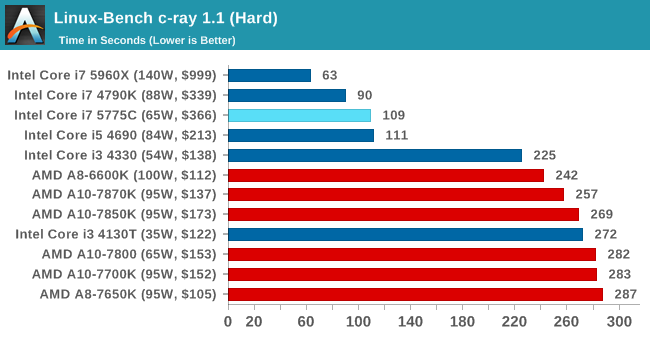
NAMD, Scalable Molecular Dynamics: link
Developed by the Theoretical and Computational Biophysics Group at the University of Illinois at Urbana-Champaign, NAMD is a set of parallel molecular dynamics codes for extreme parallelization up to and beyond 200,000 cores. The reference paper detailing NAMD has over 4000 citations, and our testing runs a small simulation where the calculation steps per unit time is the output vector.
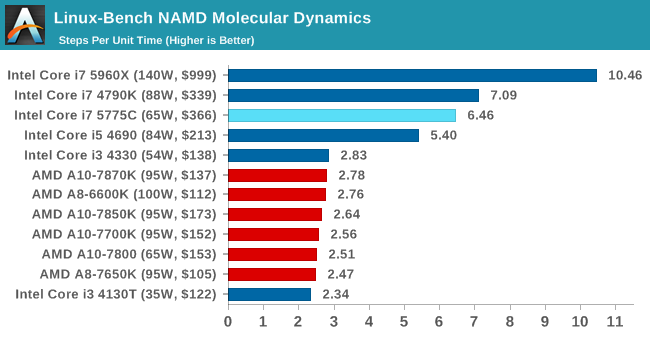
NPB, Fluid Dynamics: link
Aside from LINPACK, there are many other ways to benchmark supercomputers in terms of how effective they are for various types of mathematical processes. The NAS Parallel Benchmarks (NPB) are a set of small programs originally designed for NASA to test their supercomputers in terms of fluid dynamics simulations, useful for airflow reactions and design.
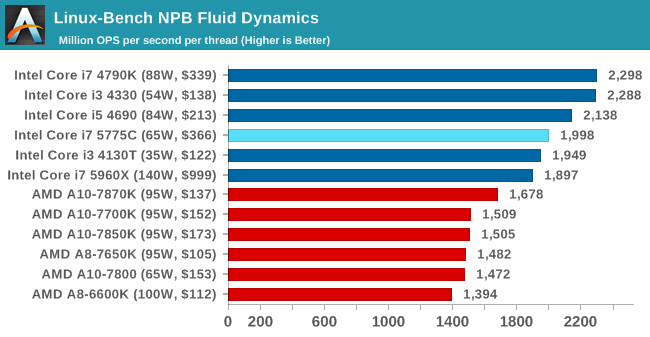
Redis: link
Many of the online applications rely on key-value caches and data structure servers to operate. Redis is an open-source, scalable web technology with a b developer base, but also relies heavily on memory bandwidth as well as CPU performance.
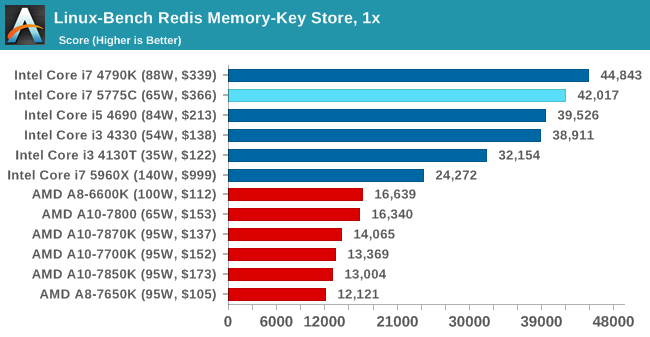
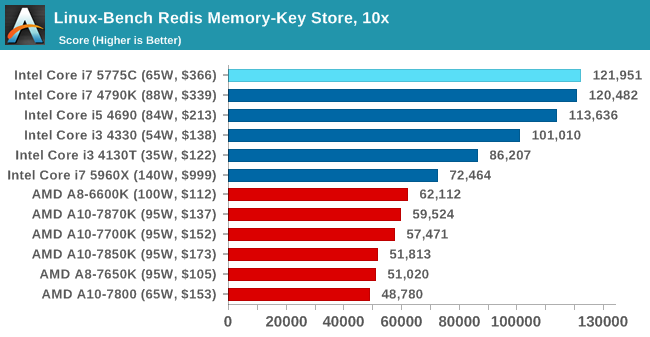
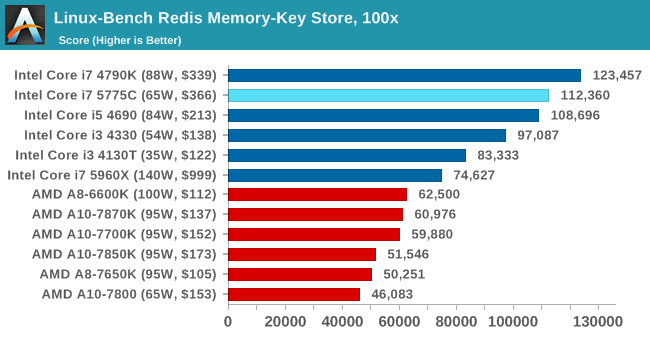










196 Comments
View All Comments
ryrynz - Wednesday, June 3, 2015 - link
Fairly certain it's 64MB on more than one of them.Ryan Smith - Wednesday, June 3, 2015 - link
All GT3e parts have 128MB of eDRAM. Did we mess up and put the wrong value at some point in this article?patrickjp93 - Thursday, June 4, 2015 - link
No, you're right. 64MB version of Crystalwell is coming to Skylake only as far as I'm aware.Laststop311 - Wednesday, June 3, 2015 - link
Wow Intel wont even let AMD keep the better iGPU performance crown. At least APU's had higher gaming performance going for them. Now they really have nothing. Plus this part uses less power and runs cooler than amd's igpu. Intel's engineering and process advantage is really showing. If I was building an HTPC this chip would be my go to. Can actually play any game with decent settings on it. Turn ur HTPC into a console PC gaming machine as well.The_Assimilator - Wednesday, June 3, 2015 - link
"Now they really have nothing."Couldn't have put it better myself. APUs were AMD's last card, and Intel just took that card out vof AMD's hand. If Zen isn't the second coming that's been promised (and I doubt it because of AMD's marketing track record), then AMD's CPU division is effectively dead.
Oxford Guy - Saturday, June 6, 2015 - link
That's what Anandtech would have people believe. In reality the FX chips like the $100 8320E (I paid $133.75 with an 8 phase power motherboard from Microcenter) is very competitive for things like h.265 encoding, Blender, and so on with Intel -- especially on performance per dollar.So, Anandtech sticks 6 APUs in its charts and not a single 8 thread FX chip.
Oxford Guy - Saturday, June 6, 2015 - link
Example... top scoring APU in Cinebench multithread: 3258 thread FX at just 3.33 GHz: 540
at a more reasonable 4.28 GHz: 683
4.56 GHz: 724
4.78 GHz: 765
kevinkga - Wednesday, June 3, 2015 - link
I love it that you have a Linux section and I was even pleasantly surprised to see Redis benchmarks, which I use a lot! For my purposes I'm investigating using:1. MAXIMUS VII IMPACT MINI-ITX board (because it's the only ITX on the market afaik that supports M.2 x4. Other ITX boards seem to only support M.2 x2 although they often don't make it clear.)
2. Samsung XP941 128GB
3. M350 ITX case
4. Fedora 22 OS
xchaotic - Wednesday, June 3, 2015 - link
"Samsung XP941 128GB" - a bit small I think - best to get 256GB straight away.boozed - Wednesday, June 3, 2015 - link
A salient question perhaps, but I wouldn't go calling it a poignant one.